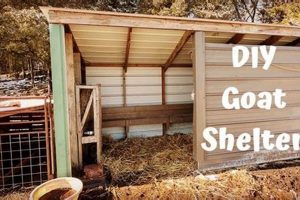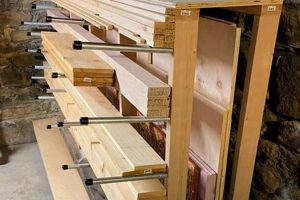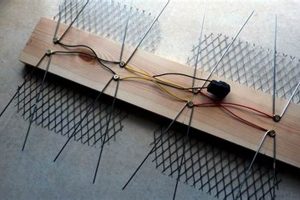A self-constructed wood-splitting apparatus provides an alternative to purchasing commercially manufactured units. These projects, undertaken by individuals with varying levels of mechanical skill, aim to create a functional device capable of dividing logs into smaller pieces for firewood or other purposes. Such constructions often involve adapting existing hydraulic systems, repurposing steel components, and employing welding techniques.
Creating a personal wood-splitting system offers potential cost savings and the satisfaction of a hands-on project. Historically, individuals have relied on manual splitting methods using axes and wedges. The advent of hydraulic power introduced a more efficient approach, leading to the development of both commercial and amateur-built log-splitting machines. These systems can increase productivity and reduce physical strain associated with traditional methods.
The following sections will examine the key considerations in designing and building these systems, including hydraulic power requirements, structural integrity, safety measures, and the selection of appropriate components. These aspects are crucial for achieving a functional and safe operating outcome.
Construction and Operation Guidance
The following guidance aims to offer practical advice for the creation and safe use of self-constructed wood-splitting equipment. Attention to these details is paramount for both functionality and user safety.
Tip 1: Hydraulic System Selection: Carefully determine the tonnage requirement based on the type and size of wood to be split. Undersized systems will be ineffective, while oversized systems increase cost and complexity. A minimum of 20 tons of force is generally recommended for hardwoods.
Tip 2: Structural Steel Integrity: Employ high-strength steel for the frame and wedge. Ensure all welds are performed by a qualified individual and inspected for proper penetration and absence of defects. Weak welds constitute a critical failure point.
Tip 3: Hydraulic Cylinder Specifications: Select a cylinder with adequate stroke length to accommodate the typical log size. The cylinder’s bore diameter and operating pressure should match the hydraulic pump’s capabilities. Overloading the cylinder can lead to premature failure.
Tip 4: Control Valve Placement: Position the control valve in a location that allows for safe operation and prevents accidental activation. A detent valve can reduce operator fatigue but must be paired with appropriate safety interlocks.
Tip 5: Safety Interlocks and Guards: Implement safety features such as two-handed operation to prevent accidental hand placement in the splitting zone. Install guards to deflect wood fragments and prevent contact with moving parts.
Tip 6: Fluid Compatibility: Ensure the hydraulic fluid used is compatible with the pump, cylinder, and hoses. Using the wrong fluid can lead to seal degradation and system malfunction. Consult the manufacturer’s specifications for recommended fluids.
Tip 7: Regular Inspection and Maintenance: Routinely inspect all components for signs of wear, leaks, or damage. Replace worn parts promptly. Regularly check and maintain hydraulic fluid levels to prevent pump cavitation.
Adhering to these recommendations promotes a safer and more efficient wood-splitting experience. Proper planning and execution are crucial for success.
The subsequent sections will address advanced design considerations and potential modifications to tailor the system to specific needs.
1. Hydraulic Power Tonnage
Hydraulic power tonnage is a primary determinant in the functionality of a self-constructed wood-splitting apparatus. Insufficient force compromises the device’s ability to effectively split dense or knotty logs, rendering it largely ineffective. Therefore, understanding the relationship between hydraulic tonnage and wood density is crucial for a successful build.
- Minimum Tonnage Requirements
The minimum tonnage necessary is dictated by the species and average diameter of logs processed. Softwoods, such as pine, require less force than hardwoods like oak or maple. A self-constructed apparatus intended primarily for softwoods may function adequately with 10-15 tons of force, whereas hardwoods necessitate a range of 20-30 tons, or even higher for particularly large or dense specimens.
- Cylinder Bore and Pressure Relationship
Hydraulic tonnage is a direct function of the cylinder bore diameter and the system’s operating pressure. A larger bore diameter, at a given pressure, generates greater force. However, increasing pressure without increasing bore diameter can strain components and potentially lead to failure. Careful calculation of cylinder bore and operating pressure is paramount to achieving the desired tonnage without exceeding component limits.
- Pump Flow Rate and Cycle Time
While tonnage dictates the force of the split, pump flow rate determines the speed of the cylinder’s movement. A low flow rate, even with sufficient tonnage, will result in slow, inefficient operation. Conversely, an excessively high flow rate might exceed the cylinder’s capacity or create instability. Optimal pump selection balances flow rate with tonnage requirements to achieve a reasonable splitting cycle time.
- Valve Capacity and System Relief
The hydraulic control valve must be rated to handle the system’s flow rate and pressure. Undersized valves create flow restrictions, reducing efficiency and potentially generating excessive heat. A properly sized relief valve is essential as a safety mechanism, preventing over-pressurization and protecting components from damage in the event of a blockage or excessive resistance.
The effective application of hydraulic power is not simply a matter of maximizing tonnage. It requires a holistic understanding of the interdependencies between cylinder specifications, pump performance, valve capacity, and system relief. Thoughtful consideration of these factors optimizes the functionality and longevity of the wood-splitting apparatus.
2. Weld Integrity Criticality
The structural integrity of a self-constructed wood-splitting apparatus is inextricably linked to the quality of its welds. Welding constitutes a fundamental construction process, joining individual steel components to form a cohesive and load-bearing frame. Deficiencies in weld quality compromise the entire structure, presenting a significant safety hazard and potentially leading to catastrophic failure under load. The repetitive stresses inherent in wood splitting magnify the impact of substandard welds. For instance, a weld exhibiting porosity or lack of fusion can propagate cracks over time, ultimately causing the
weld to separate. This can result in projectiles being ejected from the apparatus at high velocity, posing a severe risk to the operator and bystanders.
The criticality of weld integrity extends beyond the primary frame to encompass welds on the splitting wedge, cylinder mounting points, and any reinforcement structures. Each weld must be capable of withstanding the calculated forces generated by the hydraulic system. A practical example highlights this importance: if the weld securing the hydraulic cylinder to the frame fails, the uncontrolled release of hydraulic pressure can propel the cylinder with considerable force, creating an extremely dangerous situation. Proper weld preparation, including beveling edges and ensuring clean surfaces, is essential for achieving adequate penetration. Furthermore, selecting the appropriate welding process and filler material for the specific type of steel used is critical for ensuring weld strength and ductility.
In summary, weld integrity is not merely a cosmetic concern but rather a paramount safety requirement in the fabrication of a wood-splitting apparatus. The consequences of weld failure range from reduced efficiency and premature component wear to catastrophic structural collapse and potential serious injury. Adherence to established welding codes and practices, coupled with thorough inspection of all welds, is indispensable for mitigating these risks and ensuring the safe and reliable operation of the equipment. A challenge lies in ensuring that amateur builders possess the necessary welding skills and knowledge to execute welds that meet stringent structural requirements.
3. Cylinder Stroke Length
Cylinder stroke length is a critical specification in the design and functionality of a self-constructed wood-splitting apparatus. This dimension directly dictates the maximum log length the apparatus can accommodate, influencing operational efficiency and overall utility.
- Maximum Log Length Accommodation
The stroke length of the hydraulic cylinder determines the longest log that can be completely split in a single cycle. A stroke length shorter than the average log length necessitates repositioning the log and performing multiple splits, significantly reducing productivity. A practical scenario involves attempting to split a 24-inch log with a cylinder having a 12-inch stroke. The log would require at least two splitting cycles, impacting operational efficiency. Selection of appropriate stroke is thus integral to the apparatus’s effectiveness.
- Impact on Splitting Force Distribution
Stroke length indirectly influences the distribution of splitting force. A longer stroke, combined with an improperly sized wedge, can lead to increased stress on the cylinder rod during the extended phases of the splitting cycle. This increased stress can accelerate wear and tear on the cylinder seals and potentially lead to premature failure. A system with a relatively long stroke should be paired with a wedge designed to concentrate force at the point of initial contact with the log, minimizing stress on the cylinder during the later stages of the splitting process.
- Influence on Cycle Time
While hydraulic pump flow rate is the primary determinant of cycle time, cylinder stroke length plays a secondary role. A longer stroke requires a greater volume of hydraulic fluid to complete a full cycle, potentially increasing the overall time required for each split. This increased cycle time can impact the overall productivity of the system, particularly when processing a large volume of wood. Consideration should be given to optimizing the stroke length to minimize cycle time without compromising the apparatus’s ability to accommodate typical log lengths.
- Physical Space Requirements
The cylinder’s stroke length impacts the overall footprint of the splitter. A longer stroke inherently requires more space for the cylinder to extend and retract fully. This aspect is critical when considering storage space and the physical environment where the apparatus will be operated. Space limitations may necessitate a compromise between desired stroke length and practical spatial constraints. A detailed assessment of the available workspace is a prerequisite for determining the optimal cylinder stroke length.
These facets, when considered collectively, underscore the importance of meticulously selecting a cylinder stroke length that aligns with both operational requirements and physical limitations. This selection process is vital to maximizing the efficiency, safety, and overall utility of a self-constructed wood-splitting apparatus. A pragmatic approach involves analyzing the specific log sizes typically encountered and then choosing a cylinder stroke length that comfortably accommodates those dimensions, while also factoring in space constraints and component limitations.
4. Control Valve Safety
The control valve is a critical component in self-constructed wood-splitting apparatuses, governing the movement of the hydraulic cylinder and, consequently, the splitting process. Its design and proper operation are paramount for operator safety and the prevention of equipment damage. A malfunctioning or improperly configured control valve can result in uncontrolled cylinder movement, posing a significant risk of injury.
- Valve Type and Detent Functionality
The type of control valve employed directly impacts safety. Detent valves, which hold the cylinder in a specific position without continuous operator input, are commonly used to reduce operator fatigue. However, if the detent mechanism fails or is inadvertently disengaged, the cylinder can rapidly retract or extend, potentially causing injury or damage. Spring-return-to-neutral valves, in contrast, require constant operator pressure to maintain cylinder movement, inherently providing a greater degree of control and reducing the risk of unintended movement. A detent valve’s reliability must be rigorously validated prior to its implementation.
- Valve Placement and Ergonomics
The physical placement of the control valve is a critical safety consideration. The valve should be positioned to allow for comfortable and ergonomic operation, minimizing the risk of operator fatigue or accidental activation. Furthermore, the valve should be located such that the operator has a clear view of the splitting zone and can maintain a safe distance from moving parts. Obstructed views or awkward operating positions increase the likelihood of errors and potential injury. Consider an emergency stop mechanism easily accessible from the control valve location.
- Two-Handed Operation Interlocks
To mitigate the risk of hand injuries, many wood-splitting apparatuses incorporate two-handed operation interlocks. These systems require the operator to use both hands to activate the control valve, ensuring that neither hand is in the splitting zone during operation. The interlock mechanism must be designed to prevent circumvention and should be regularly inspected to ensure its proper functionality. A compromised or bypassed interlock significantly increases the risk of hand injuries.
- Pressure Relief and Overload Protection
The control valve should be equipped with an integrated pressure relief valve to prevent over-pressurization of the h
ydraulic system. In the event of a log becoming lodged or the cylinder encountering excessive resistance, the relief valve will automatically vent excess pressure, preventing damage to the pump, cylinder, and other hydraulic components. The relief valve setting should be carefully calibrated to match the system’s design parameters and should be tested periodically to ensure proper operation. The absence of a functional relief valve can lead to catastrophic component failure and potential explosive hazards.
In summary, the control valve is not merely a component for directing hydraulic fluid; it is a critical safety device in a self-constructed wood-splitting apparatus. Careful consideration of valve type, placement, interlocks, and pressure relief mechanisms is essential for minimizing the risk of injury and ensuring the safe and reliable operation of the equipment. The integration of failsafe mechanisms, robust construction, and regular inspection protocols are indispensable for mitigating the inherent hazards associated with hydraulic power.
5. Maintenance Inspection Frequency
Regular maintenance inspections are vital to the safe and reliable operation of any self-constructed wood-splitting apparatus. These inspections are not merely perfunctory checks but rather critical assessments of component integrity and overall system health, essential for mitigating potential hazards and extending the equipment’s lifespan. The frequency of these inspections should be commensurate with the apparatus’s usage intensity and operating environment.
- Hydraulic System Integrity
Frequent inspection of the hydraulic system is paramount. This includes scrutinizing hoses for cracks, abrasions, or leaks; examining fittings for tightness and corrosion; and monitoring the hydraulic fluid level and condition. A degraded hose can rupture under pressure, resulting in a high-velocity spray of hydraulic fluid, posing a significant injury risk. Similarly, low fluid levels can lead to pump cavitation and reduced splitting force. An inspection regime should encompass visual checks before each use, along with a more comprehensive examination on a weekly or monthly basis, depending on usage.
- Structural Weld Assessment
Welds are the backbone of a wood-splitting apparatus, and their integrity is crucial for structural stability. Inspections should focus on identifying any signs of cracking, porosity, or fatigue in the welds. Such defects can compromise the frame’s ability to withstand the forces generated during splitting, potentially leading to catastrophic failure. Weld inspections should be conducted visually, aided by techniques like dye penetrant testing for more critical areas. Post-operation cool-down periods offer ideal opportunities for visual assessment, mitigating thermal expansion effects.
- Mechanical Component Wear
Regularly inspecting mechanical components, such as the splitting wedge, cylinder rod, and any moving linkages, is essential for identifying wear and tear. A worn splitting wedge can lose its effectiveness, requiring increased force to split logs and potentially overloading the hydraulic system. Similarly, a damaged cylinder rod can cause seal failure and hydraulic fluid leakage. Inspections should involve visual checks for damage, as well as functional tests to ensure smooth and efficient operation. Replace worn components promptly to prevent further damage and maintain optimal performance.
- Safety Device Functionality
Any safety devices incorporated into the apparatus, such as two-handed operation interlocks, emergency stop mechanisms, and safety guards, must be inspected regularly to ensure their proper functionality. A malfunctioning safety device negates its protective benefit, increasing the risk of operator injury. Inspections should include functional tests to verify that the devices are operating as intended, as well as visual checks for any signs of damage or tampering. Safety device integrity is not optional but a fundamental requirement for safe operation.
The synergistic effect of consistent and thorough maintenance inspections cannot be overstated. By proactively addressing potential issues before they escalate into major problems, the longevity, efficiency, and, most importantly, the safety of a self-constructed wood-splitting apparatus can be significantly enhanced. A documented maintenance schedule, detailing inspection intervals and procedures, serves as a valuable tool for ensuring adherence to best practices and promoting a culture of safety-consciousness.
Frequently Asked Questions
The following section addresses common inquiries and concerns regarding the design, construction, and operation of self-constructed wood-splitting apparatuses. The information presented aims to provide clarity and guidance for individuals considering undertaking such projects.
Question 1: What is the minimum hydraulic tonnage required for a self-constructed wood-splitting apparatus?
The minimum hydraulic tonnage is dependent on the type of wood to be split. Softwoods generally require 10-15 tons, while hardwoods necessitate a minimum of 20 tons, potentially exceeding 30 tons for dense or knotty varieties. Insufficient tonnage renders the apparatus ineffective for its intended purpose.
Question 2: How critical is weld quality in a self-constructed wood-splitting apparatus?
Weld quality is of paramount importance. Welds constitute the structural foundation of the apparatus, and deficiencies can lead to catastrophic failure under load. Proper weld preparation, technique, and inspection are indispensable for ensuring operator safety.
Question 3: How does hydraulic cylinder stroke length impact the apparatus’s functionality?
The cylinder stroke length determines the maximum log length the apparatus can accommodate. A stroke length shorter than the typical log length necessitates multiple splitting cycles, reducing efficiency. Optimizing stroke length for the intended log size range is crucial.
Question 4: What safety features are essential for a self-constructed wood-splitting apparatus?
Essential safety features include two-handed operation interlocks, a pressure relief valve, and strategically placed safety guards. These features mitigate the risk of injury and equipment damage by preventing unintended operation and over-pressurization.
Question 5: How often should maintenance inspections be performed on a self-constructed wood-splitting apparatus?
Maintenance inspections should be performed regularly, with the frequency determined by usage intensity. Hydraulic systems, welds, mechanical components, and safety devices all require periodic examination to identify potential issues before they escalate.
Question 6: What are the potential risks associated with operating a self-constructed wood-splitting apparatus?
Potential risks include projectile hazards from improperly secured logs or component failure, hydraulic fluid injection injuries from ruptured hoses, and crush injuries from uncontrolled cylinder movement. Adherence to safety protocols and regular maintenance are crucial for mitigating these risks.
These FAQs underscore the importance of careful planning, meticulous construction, and diligent maintenance when undertaking the creation of a self-constructed wood-splitting apparatus. Prioritizing safety and adhering to established engineering principles
are fundamental to a successful project.
The subsequent section will explore advanced design considerations for optimizing the performance and versatility of self-constructed wood-splitting apparatuses.
Conclusion
The preceding exploration of the self-constructed wood-splitting apparatus the “diy log splitter” has underscored the multifaceted considerations inherent in such projects. Key aspects, encompassing hydraulic power, structural integrity, and safety mechanisms, demand meticulous attention to detail. The effective execution of a functional and safe apparatus relies on a comprehensive understanding of these principles.
Therefore, those undertaking the construction of a “diy log splitter” must prioritize informed decision-making and rigorous adherence to safety protocols. The potential consequences of negligence or inadequate planning extend beyond equipment damage to include significant personal risk. Continued education and a commitment to best practices are essential for realizing a successful and safe outcome. Diligence should be paramount.







